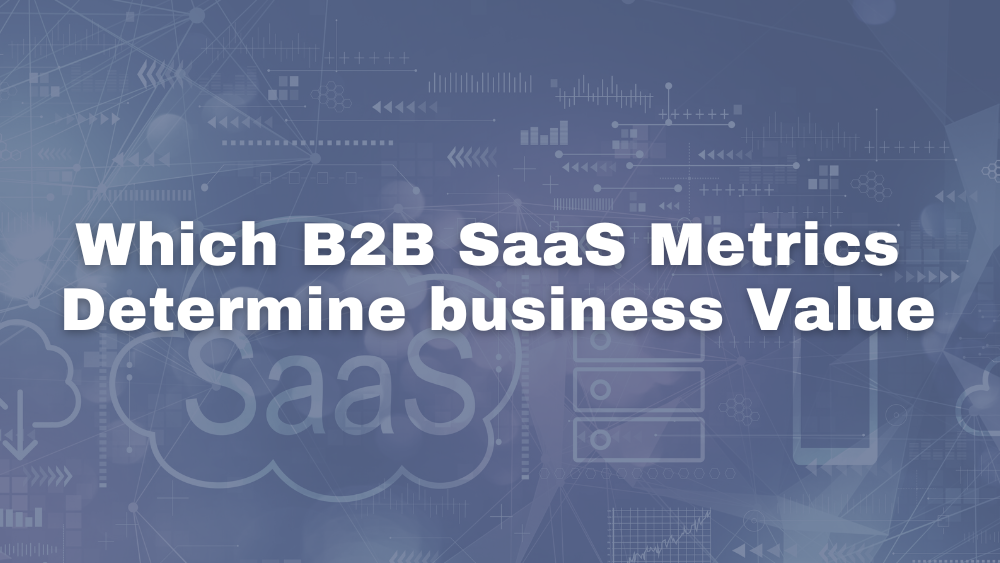B2B SaaS Metrics that Determine the Value of Your Business

B2B SaaS Metrics that Determine the Value of Your Business

When it comes to maximizing the value of your software business, which B2B SaaS metrics should you be focusing on?
If we’re talking about the monetary value of a business, in software, this comes down to what’s called the annualized recurring revenue (ARR). Revenue growth is one of the first things that someone will look at for an acquisition or an investment.
Next is gross margin and the efficiency of the operating expenses – everything below the gross margin line.
Another key metric is the software’s ease of use or rate of adoptability.
So, there isn’t just one metric to increase the value of your business. It’s revenue, rate of adoptability, and gross margin.
For a detailed explanation of metrics to track when going in front of an investment board, check out our article covering SaaS Metrics for Investors.
B2B SaaS Metrics to Monitor
To effectively monitor the value of your business, you need to understand what they are and how they affect your business as a whole. As mentioned above, those metrics are:
Annual Recurring Revenue
Annual Recurring (ARR) is the yearly value of the recurring revenue elements of your term subscriptions. Monitoring ARR allows businesses to view the health of their reoccurring revenue and can be an indicator if any changes are needed to business strategy.
It’s important to remember that ARR can be gathered from multiple components like:
- ARR from new customers
- ARR from renewal of customer contracts
- ARR growth from system updates or add-ons
- ARR losses from losing customers or downgrading systems
Gross Margin
The term gross margin refers to the net sales of a business less than the cost of goods sold. Basically, it’s the remaining money a business has after the production costs for the goods and services it provides.
Consider a restaurant. The gross margin of the restaurant would be calculated by taking the net sales and deducting the cost of the food supplies, payroll, and any other financial obligations of the business. The higher the gross margin is, the more capital that the restaurant retains for other financial obligations. To track this metric, follow the net sales figure of gross revenue, minus any returns, discounts, or allowances associated with your business.
Rate of Adoption
The third metric to monitor is the rate of adoption. Rate of adoption refers to the pace that customers implement new systems, technologies, or services. To accurately monitor the rate of adoption, business owners should analyze the number of people who use the new product over a specific period of time. Then, that rate can be compared between different periods or compared between new users and the entire product market.
Monitoring rate of adoption can give visibility to the ease of use of the product. Let’s take Zoom for example. Zoom took off because of COVID.
Zoom, Google Meets, and Go To Meeting had all been on the market for a while. It’s not like video conferencing came out of nowhere at the onset of COVID. However, out of the all programs available, Zoom is the one that really took off. Well, why is that? It was easy to use. You plug it in and play. Ease of use propelled Zoom to the forefront of the market.

Goals Determine Your Perceived Value
Before you can determine the value of your business you need to define your business goals. Are you in business to exit and get a big payday? Or are you in business to make a living and continue to be in that business for a long time?
SaaS Gurus is part of an industry where many of the client’s goals are to exit in three or five years. They’re looking to grow a company, get that revenue high as fast as possible, exit, and get a payday. That’s a very different business strategy from somebody who says, “I want to grow a company where I’m employing people for 10 or 20 years.”
So, value is in the eye of the CEO and the founder. If your goal is to get a big payday and exit, the value of your business is the paycheck in the end. If your goal is to grow a company and stay with it, the value is much different. It’s giving people rewarding work to do, finding employment for people, and supporting their families. Those goals are not mutually exclusive, but they’re different in terms of how you approach the business.
Anthony Nitsos, Founder and Fractional CFO
Anthony Nitsos elevates your financial strategy to meet challenges and drive your company value. Working with pre-seed to Series B stage SaaS startups, he ensures that founders have reliable metrics and a solid understanding of the true economics of their business to maximize valuation. He optimizes financial operations, sales operations, human resources operations, and risk management systems. He’s worked with various startups, including two unicorn exits.

